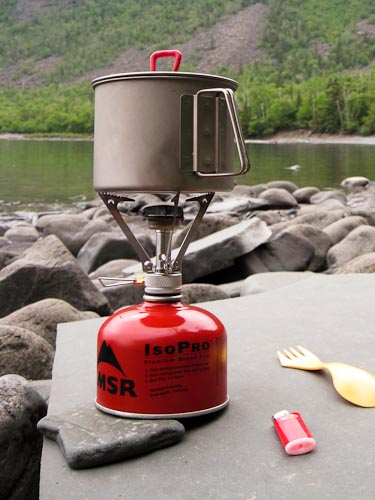MSR Pocket Rocket review
The MSR Pocket Rocket stove is a single-burner isobutane-fueled backpacking stove. It is very light, very compact, and very easy to use.
Background
Growing up, I had always used white gas stoves. My dad used to bring a big green Coleman two-burner white gas stove with us when we went camping on Minnesota’s North Shore. While backpacking in Boy Scouts, we used MSR WhisperLite stoves, which were small but had what seemed like only two modes: on and off.
After college, I followed in that tradition by getting myself an MSR SimmerLite white gas backpacking stove. It was a decent stove, but I didn’t like transferring fuel, keeping the stove pumped, and having to fool around with the spirit cup when lighting it. It would have been more useful on an expedition to a third-world country, where canister fuel is presumably difficult to acquire and field maintainability is important, but it was a poor fit for my needs. That’s when I picket up a Pocket Rocket.
The Good
- Very light.
- Very small.
- Easy to light. No priming required.
- No need to pump. Since the fuel is pre-pressurized, there is no need to manually pressurize the fuel (as was necessary with the white gas stoves).
- Convenient storage case. Includes a nice bright-red plastic storage case.
- Easy to control heat output, from “big lighter” level up to “what are you doing with that flamethrower” mode, and everything in between.
- Doesn’t require cleaning. Or at least, I’ve never found a need to clean mine.
- Doesn’t get full of soot.
- Fits in an MSR Titan titanium kettle along with a 4 oz fuel canister. It’s a tight fit, and the red plastic storage case included with the stove won’t squeeze in too, but there you are. I never transport my Pocket Rocket like this, as I prefer to use 8 oz fuel canisters and store the fuel alone inside the Titan kettle. (Side note about that: be sure the kettle is totally dry when you put the fuel canister into it, or else the bottom of the fuel canister will rust.)
- Can boil water fast. It takes just a few minutes in calm weather to boil a liter of water.
- Surprisingly stable. I was concerned about the stability of the stove given how far up the pots and pans sit, but it hasn’t been an issue in the field.
- Inexpensive. For $40, you can’t beat it.

MSR Pocket Rocket, shown with an 8 oz isobutane fuel canister and the MSR Titan titanium kettle.
The Bad
- Not very effective in the wind. The design of the stove, with the burner on top of the fuel canister, makes it risky and difficult to add a heat reflector. The hazard is that the reflector would cause the fuel canister to overheat. As a result, the stove is highly susceptible to wind. When the wind is blowing hard, it can be very difficult to heat water with the Pocket Rocket.
- Hard to tell how much fuel is left in the canister. This isn’t a Pocket Rocket specific problem, but rather something to be aware of whenever using a canister-fueled stove. There are a couple of methods that can be used to estimate the fuel remaining, such as feeling for the level at which the canister gets really cold while in use. The most effective way to gauge the remaining fuel is to weigh the canister with a kitchen scale when new and write down that gross weight on the canister with a Sharpie. Later you can weigh the canister again to see how much fuel has been used. By comparing that delta with the factory-indicated net fuel weight, you can determine how much fuel remains in the canister.
Conclusion
The Pocket Rocket is a great backpacking stove. I see them a lot on the trail, and everybody seems to love them. As long as you can keep it out of the wind, it works great.


Recent Comments